By Alex Trukan
With many teams being reactive and very effective on the counter attack, it is important for our teams to be able to deal with that. Preventing the counter attack and winning the ball back or forcing the opposition to be more patient going forwards will prevent the team from being caught outnumbered and getting easily beat. ‘Counter pressing’ has nowadays become a buzzword used in football very often. This high pressing strategy has been described by Jurgen Klopp as ‘the best playmaker’. If executed effectively, it is a good way of creating goalscoring opportunities. However, winning the ball straight after losing it won’t be always possible. There will be times when the opposition beats the first press and finds itself in a good position to play forwards. This might mean for the other team that they will have to defend when outnumbered and disorganised with opposition running at them using full pace. One of the key skills in these kind of situations is delaying the opponents to allow more time to recover and get organised.
First stage of delaying the opposition is the press in itself. Straight after losing the ball, a team would be looking to apply pressure on the ball, get compact around it and try to win possession back. If winning the ball back is not the case, the next priority is to force it backwards or sideways. This initial reaction will prevent the opposition from getting the ball forwards quickly and naturally delay their counter attack. The danger arises if the opposition manages to get past the first pressing block.
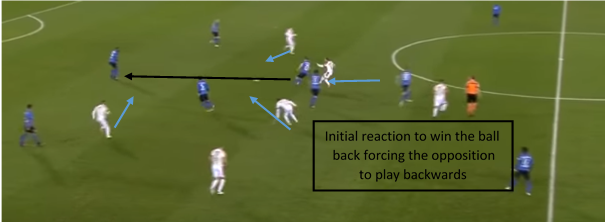
As the pressing team utilises a number of players around the ball, there will be spaces available and players left behind the ball if the opposition breaks through. In this situation, the key priority would be to delay the opposition and get organised as a team. In the areas where there is no direct threat to a goal (i.e. shot), players in front of the ball should be facing the ball and keep moving backwards. This prevents the player on the ball to take bigger touches and run into space forcing him to slow down.
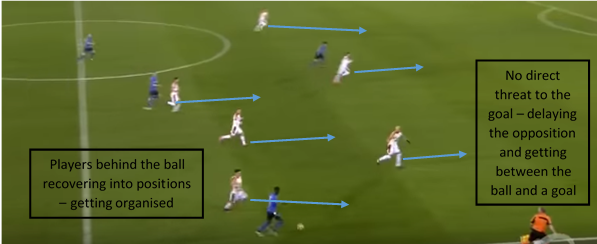
Opposition slowing down will mean more chances for players behind the ball to make recovery runs. These should be made as quick as possible, into available spaces, with a priority to cover central areas and get between the ball and a goal. The whole team should get compact and narrow. Players around the ball should be prioritised before players away from it.
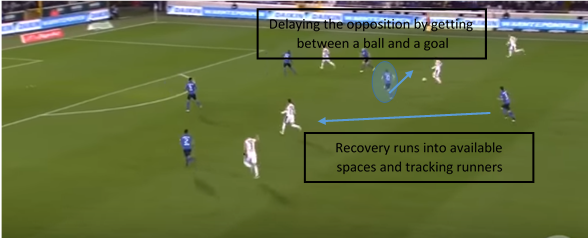
If the delaying player gets caught in wide areas, with no support from the back, there will be spaces left for the opposition to run into. Similarly, getting to close to the player with the ball will make it harder to react quickly and turn as the opposition player gets in behind.
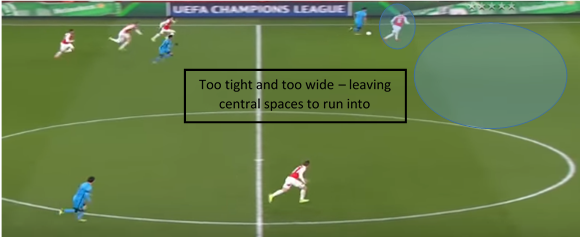
Players in front of the ball will often have to do ‘half-half’ job which means having two responsibilities. As we can see below, last defender has to both delay the player on the ball by forcing him into wider areas as well as prevent a pass into opposition striker who is positioned closer to the goal. It will be often tempting to apply the pressure on the ball earlier, but delaying player should resist it, stay centrally and prioritise danger. Speed of recovery is crucial – the earlier they start the run, the more chances they have to get organised.
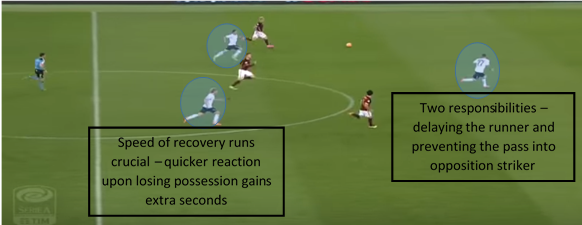
As the opposition arrives into spaces within a direct threat to the goal, the player that has been delaying will have to eventually press the ball. When this happens will be largely dependant on the amount and positions of defending players behind the ball. The more players managed to recover and the more organised the team is, the earlier press can be applied. This will be also dependant on the opposition players in front of the ball. Press can be only applied with a sufficient support and cover from the back.
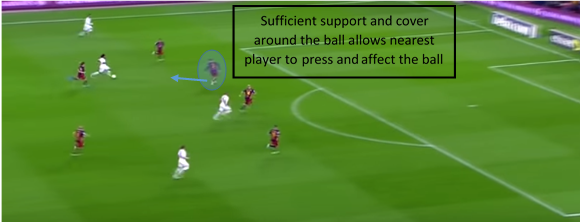
Goalkeeper is part of the team and therefore should be used strategically. As a last resort, defender might try to force the attacking player to shoot on goal (and let the goalkeeper deal with it) from certain areas rather than passing it to a player in a better position (i.e. closer to the goal). Goalkeeper has more chances of saving a shot from inside the penalty box than a tap in after a pass across the goal. Great part of defending is calculating risks and managing priorities. The best defenders can easily deal with being outnumbered thanks to these abilities. Having defenders who can be left matched or even outnumbered will allow more players to take part in attack and overload opposition on their half.
By Alex Trukan, Development Coach, Nottingham Forest
@AlexTrukan


